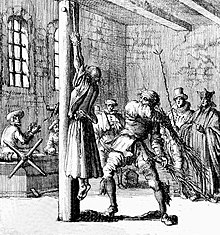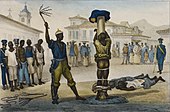
A corporal punishment or a physical punishment is a punishment which is intended to cause physical pain to a person. When it is inflicted on minors, especially in home and school settings, its methods may include spanking or paddling. When it is inflicted on adults, it may be inflicted on prisoners and slaves.

Flagellation, flogging or whipping is the act of beating the human body with special implements such as whips, rods, switches, the cat o' nine tails, the sjambok, the knout, etc. Typically, flogging has been imposed on an unwilling subject as a punishment; however, it can also be submitted to willingly and even done by oneself in sadomasochistic or religious contexts.

In criminal justice, particularly in North America, correction, corrections, and correctional, are umbrella terms describing a variety of functions typically carried out by government agencies, and involving the punishment, treatment, and supervision of persons who have been convicted of crimes. These functions commonly include imprisonment, parole, and probation. A typical correctional institution is a prison. A correctional system, also known as a penal system, thus refers to a network of agencies that administer a jurisdiction's prisons, and community-based programs like parole, and probation boards. This system is part of the larger criminal justice system, which additionally includes police, prosecution and courts. Jurisdictions throughout Canada and the US have ministries or departments, respectively, of corrections, correctional services, or similarly-named agencies.
A Borstal was a type of youth detention centre in the United Kingdom, several member states of the Commonwealth and the Republic of Ireland. In India, such a detention centre is known as a Borstal school.

Caning is a form of corporal punishment consisting of a number of hits with a single cane usually made of rattan, generally applied to the offender's bare or clothed buttocks or hands. Caning on the knuckles or shoulders is much less common. Caning can also be applied to the soles of the feet. The size and flexibility of the cane and the mode of application, as well as the number of the strokes, vary greatly—from a couple of light strokes with a small cane across the seat of a junior schoolboy's trousers, to up to 24 very hard, wounding cuts on the bare buttocks with a large, heavy, soaked rattan as a judicial punishment in some Southeast Asian countries.

Public humiliation or public shaming is a form of punishment whose main feature is dishonoring or disgracing a person, usually an offender or a prisoner, especially in a public place. It was regularly used as a form of judicially sanctioned punishment in previous centuries, and is still practiced by different means in the modern era.

A switch is a flexible rod which is typically used for corporal punishment. Switching is similar to birching.

The cat o' nine tails, commonly shortened to the cat, is a type of multi-tailed whip or flail that originated as an implement for severe physical punishment, notably in the Royal Navy and British Army, and as a judicial punishment in Britain and some other countries.

The tawse, sometimes formerly spelled taws is an implement used for corporal punishment. It was used for educational discipline, primarily in Scotland, but also in schools in a few English cities e.g. Newcastle upon Tyne, Gateshead, Liverpool, Manchester and Walsall.
A reformatory or reformatory school is a youth detention center or an adult correctional facility popular during the late 19th and early 20th centuries in Western countries. In the United Kingdom and United States, they came out of social concerns about cities, poverty, immigration, and gender following industrialization, as well as from a shift in penology to reforming instead of punishing the criminal. They were traditionally single-sex institutions that relied on education, vocational training, and removal from the city. Although their use declined throughout the 20th century, their impact can be seen in practices like the United States' continued implementation of parole and the indeterminate sentence.

Caning is a widely used form of corporal punishment in Singapore. It can be divided into several contexts: judicial, prison, reformatory, military, school, and domestic. These practices of caning as punishment were introduced during the period of British colonial rule in Singapore. Similar forms of corporal punishment are also used in some other former British colonies, including two of Singapore's neighbouring countries, Malaysia and Brunei.
Community sentence or alternative sentencing or non-custodial sentence is a collective name in criminal justice for all the different ways in which courts can punish a defendant who has been convicted of committing an offence, other than through a custodial sentence or capital punishment (death).

Strapping refers to the use of a strap as an implement of corporal punishment. It is typically a broad and heavy strip of leather, often with a hard handle, the more flexible 'blade' being applied to the offender.

Caning is used as a form of corporal punishment in Malaysia. It can be divided into at least four contexts: judicial/prison, school, domestic, and sharia/syariah. Of these, the first is largely a legacy of British colonial rule in the territories that are now part of Malaysia, particularly Malaya.

Judicial corporal punishment (JCP) is the infliction of corporal punishment as a result of a sentence imposed on an offender by a court of law. The punishments include caning, bastinado, birching, whipping, or strapping. The practice was once commonplace in many countries, but over time it has been abolished in most countries, although still remaining a form of legal punishment in some countries including a number of former British colonies and Muslim-majority states.

Campaigns against corporal punishment aim to reduce or eliminate corporal punishment of minors by instigating legal and cultural changes in the areas where such punishments are practiced. Such campaigns date mostly from the late 20th century, although occasional voices in opposition to corporal punishment existed from ancient times through to the modern era.
Trial as an adult is a situation in which a juvenile offender is tried as if they were an adult, whereby they may receive a longer or more serious sentence than would otherwise be possible if they were charged as a juvenile.
Robert Shuster is a British judge who has been a judge on the courts of Tonga, Fiji, and Sierra Leone. Shuster is best known for a 2010 sentence in which he ordered two teenage boys in Tonga to be whipped.
The Islamic Republic of Iran signed the UN Convention on the Rights of the Child (CRC) in 1991 and ratified it in 1994. Upon ratification, Iran made the following reservation: "If the text of the Convention is or becomes incompatible with the domestic laws and Islamic standards at any time or in any case, the Government of the Islamic Republic shall not abide by it."

Caning is used as a form of judicial corporal punishment in Brunei. This practice is heavily influenced by Brunei's history as a British protectorate from 1888 to 1984. Similar forms of corporal punishment are also used in two of Brunei's neighbouring countries, Singapore and Malaysia, which are themselves former British colonies.










